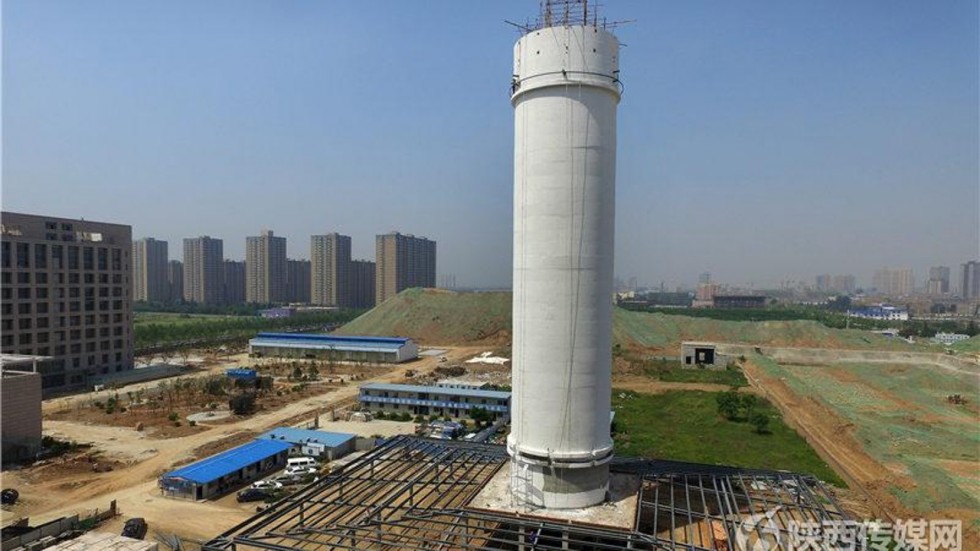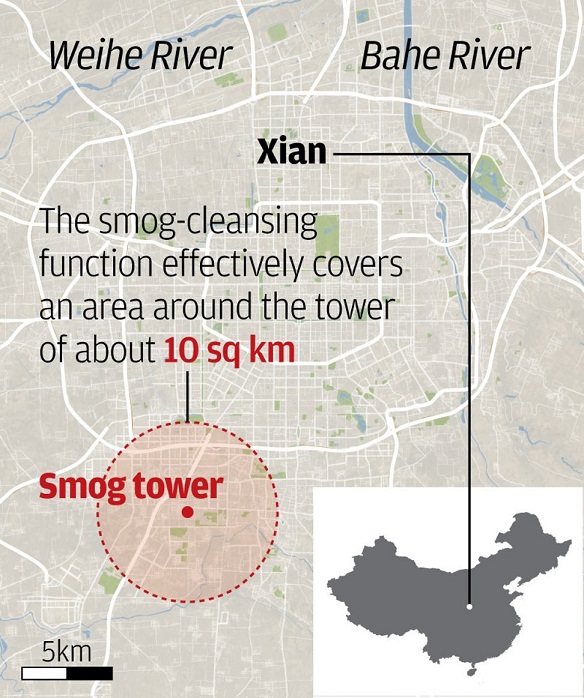China’s air purifying tower
January 16, 2018 | Expert Insights

China has built what is being considered as the world’s largest air purifier. A tower, standing at over 100 metres high, the structure has reportedly already wrought upon a noticeable improvement in the region’s air quality.
Can a similar experimental tower be the answer to India’s air pollution woes?
Background
Pollution is described as the introduction of contaminants into the natural environment. Pollutions often leads to adverse changes in the environment. It can be chemical substances or energy, such as noise, heat or light. Pollutants, the components of pollution, can be either foreign substances/energies or naturally occurring contaminants. Air pollution has existed dating back to prehistoric times when man created fire. However, the onset of urban pollution began with the burning of coal and wood. It was Industrial Revolution that began in the 18th century that gave birth to environmental pollution as we know it in modern times. The main kinds of pollution that have been classified are:
- Water Pollution.
- Air Pollution.
- Soil Pollution.
- Thermal Pollution.
- Radioactive Pollution.
- Noise Pollution.
- Light Pollution.
According to a World Health Organization report, 92% of the world’s population lives in places where air pollution exceeds safe limits. Many nations have established tax cuts and subsidies to promote electric vehicles. In the European Union, as of 2011, 15 member-states provided economic subsidies in varying degrees. Today, environmental pollution is the single largest cause of disease and death in low- and middle-income countries.
The Lancet Commission published a report in the Lancet that revealed that pollution results in the deaths of at least 9 million people annually. The report also notes that it also incurred economic damage of $4.6 trillion. The study found that India in particular recorded the highest number of deaths across the world due to pollution. In 2015, 2.5 million Indians died due to non-communicable diseases, including strokes and lung cancer, caused by pollution. China came second in the list having recorded 1.8 million such deaths. According to the Chinese Ministry of Health, industrial pollution has made cancer China's leading cause of death. Every year, ambient air pollution alone killed hundreds of thousands of citizens.
Air pollution occurs when harmful substances including particulates and biological molecules are introduced into Earth's atmosphere. It may cause diseases, allergies or death of humans; it may also cause harm to other living organisms such as animals and food crops, and may damage the natural or built environment. Human activity and natural processes can both generate air pollution.

Analysis
In 2013, China came up with a five-year to clean up the country’s killer air. The nation set aside $277 billion for the initiative and set key targets to reduce air pollution particularly for bigger cities in the country like Beijing. The government planned to reduce air emissions by 25 percent by 2017 compared with 2012 levels in those areas. After a crackdown on polluters and a sustained period of favorable weather, the country has reportedly met its target for Beijing for 2017.
China has built the world’s largest air purifier. A tower, standing at over 100 metres high, the structure has reportedly already wrought upon a noticeable improvement in the region’s air quality. According to scientists involved in the project, the tower has managed to produce more than 10 million cubic metres (353 million cubic feet) of clean air a day since it was launched. It has also improved air quality around 10kms circumference of the tower.
The head of the research, Cao Junji, said, “The tower has no peer in terms of size … the results are quite encouraging. It barely requires any power input throughout daylight hours. The idea has worked very well in the test run.”
Here’s how it works: there are greenhouses all around the base of the tower. The polluter air gets sucked into the greenhouse and gets heated due to solar power. The hot air is then purified through the various levels of filters installed in the tower. By the time it leaves the tower, it is clean air. This has been one of the country’s solution to its problem regarding smog.
Assessment
Our assessment is that China’s success in its ongoing efforts to tackle air pollution has lessons for countries like India. The capital city of Delhi, which is home to 20 million residents has continued dealing with harmless levels of toxins in its air. The city’s more than 10 million vehicles are a major contributor to the problem. Authorities must work swiftly in order to make the region safe again.








Comments